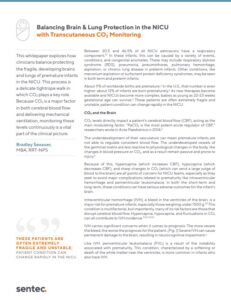Introduction
Emerging data in neonatal care points to a complicated reality: everything babies in the NICU experience – from exposure to pain to the sounds they hear – has an impact. The healthcare professionals caring for these delicate patients are constantly juggling conflicting priorities and making choices that can influence the infant’s well-being both in the short and long term. When a NICU patient must be ventilated, this challenge can feel magnified, as if caregivers are being pulled in a multitude of directions.
While crucial, ventilatory support in these fragile infants is complex and can result in competing priorities. If you are a caregiver who has managed ventilation in the NICU, these may sound familiar:
- “Try to limit mechanical ventilation days, but don’t wean until they’re ready, to avoid reintubation.”
- “Make sure CO2 doesn’t get too low, but don’t underinflate the lungs.”
- “Keep a close eye on these infants, but at the same time, let them be.”
How can NICU teams ensure that all of these priorities are adequately managed? Here, we’ll take a deeper look at NICU ventilation, the challenges that clinicians face, and strategies that can help.

FEATURED RESOURCE
This whitepaper explores the balance of protecting the fragile, developing brains and lungs of premature infants in the NICU and how CO2 plays a key role.
DOWNLOAD OUR WHITEPAPER: Balancing Brain & Lung Protection in the NICU with Transcutaneous CO2 Monitoring
Why is ventilatory support so important in the NICU?
Before digging into the challenges of ventilation management, it’s important to discuss why ventilatory support is so crucial in neonatal care. Between 20.5 and 46.5% of all NICU admissions have a respiratory component, with one of the most common conditions being neonatal respiratory distress syndrome (RDS).1,2 There are several causes of RDS in the NICU population, including:
- Pneumonia
- Aspiration
- Chronic lung disease
- Pulmonary hemorrhage
- Pleural effusion
- Congenital anomalies
Ventilatory support has a vital role within the NICU because premature infants often aren’t ready to breathe on their own. By delivering oxygen to their fragile, still-developing lungs, ventilatory support attempts to overcome the effects that RDS (as well as other conditions) may have on lung function. While ventilation is often critical for survival, the delicate nature of neonatal lungs also necessitates careful management to avoid potentially severe consequences, including injury to the lungs and brain.
Types of neonatal ventilatory support
The complicated needs of preterm infants can make decision-making regarding support modalities complex. The selection of the ventilatory support strategy depends on factors such as underlying condition, gestational age, lung maturity, and the infant’s ability to breathe spontaneously. There are several types of ventilatory support that are commonly used in the NICU:
High-Flow Nasal Cannula (HFNC):
Noninvasive form of ventilatory support that delivers a continuous high flow of humidified oxygen to the neonate through their nostrils. This method is typically used for neonates who can breathe on their own but require additional support to ensure sufficient oxygenation.
Continuous Positive Airway Pressure (CPAP):
Noninvasive method that works by delivering a continuous, set positive pressure throughout the respiratory cycle, keeping the airway open. Various modes of CPAP may be used in the NICU, including:
Bubble CPAP (bCPAP): Bubbles generated within a column of water are utilized to create and deliver a continuous positive airway pressure; typically used on spontaneously breathing infants to prevent lung collapse.
Bilevel Positive Airway Pressure (BiPAP): Positive airway pressure device that delivers two levels of air pressure: a higher pressure during inhalation and a lower pressure during exhalation.
High-Frequency Ventilation (HFV):
Involves delivering shallow, rapid breaths of air to the lungs at a high rate, typically exceeding the normal respiratory rate, with the goal of minimizing lung injury. Various types of HFV exist, including:
High-Frequency Jet Ventilation (HFJV): Combines the use of a jet ventilator and a conventional ventilator to deliver high-frequency gas pulses. During HFJV, inspiration is an active process, while exhalation is passive.
High-Frequency Oscillatory Ventilation (HFOV): Maintains a constant mean airway pressure (MAP) while generating small pressure waves or oscillations. Both the inspiration and expiration phases during HFOV are active processes.
Neurally Adjusted Ventilatory Assist (NAVA):
Ventilation method that uses electrical signals from the diaphragm to provide support that is in synchrony with the patient’s own breathing efforts. This approach aims to provide more natural and patient-specific ventilation.
Conventional Mechanical Ventilation:
Invasive technique that utilizes a positive pressure ventilator to deliver tidal breaths directly into the infant’s lungs, typically through an endotracheal or tracheostomy tube.
NICU healthcare professionals closely monitor patient response to ventilation and make adjustments accordingly, aiming to provide the best possible care and support for their delicate respiratory needs. However, some of these needs can become conflicting, leading NICU care teams to face seemingly impossible decisions.
Challenges of NICU ventilation: a balancing act between the brain & lungs
Ventilatory support plays a critical role in helping these vulnerable infants breathe and survive, but its management requires precision and care. At the heart of the conflicting priorities during neonatal ventilation is the delicate balancing act of brain and lung protection. In the world of neonatal care, the balance between providing adequate oxygenation and ventilation to support brain health, while simultaneously preventing lung injury, can be a tightrope walk.
Protecting the Brain
A paramount concern in NICU ventilation management is brain protection, especially given its particular vulnerability in neonates.
Premature infants often struggle to regulate blood flow consistently due to underdeveloped vasculature within the brain. Because of this, they are at risk for injury resulting from changes in CO2 levels. Hypercapnia (increased CO2 levels), hypocapnia (reduced CO2 levels), and rapid CO2 fluctuations are all cause for concern among NICU teams, as they can lead to dangerous complications.
During ventilation management, care teams are constantly trying to avoid these complications; intraventricular hemorrhage (IVH – bleeding in the brain’s ventricles) and periventricular leukomalacia (PVL – death of the white brain matter near the ventricles) are two major concerns. These conditions, amongst others, such as hypoxemia (low oxygen in the blood), can have serious short- and long-term effects for these infants.
Because of the risks associated, CO2 is often an essential parameter measured during neonatal ventilation, guiding clinical decision-making around adjustments that support brain protection. However, adjustments and decisions that prioritize an infant’s brain can introduce tension with the need to prioritize lung-supportive ventilation strategies.
Protecting the Lungs
The very same ventilatory support that helps keep CO2 within safe ranges for brain protection can also harm the lungs if it is not carefully managed. Depending on the patient course, clinicians may employ ventilation strategies to both protect the brain from conditions like IVH and to recruit the lungs. However, as they choose settings aimed at avoiding brain injury, their decisions can carry the risk of damaging the fragile lungs of these infants.
Due to the delicate nature of their lungs, this population is at risk for ventilator-induced lung injury (VILI), making finding the right ventilation modality and settings even more complex.3 If the volume delivered during respiratory support is insufficient, it can lead to derecruitment and atelectasis – partial or complete lung collapse. On the other hand, delivering too much volume and pressure can cause overdistension and volutrauma, which can result in serious long-term complications for these infants.
Additionally, premature infants face an increased vulnerability to a condition called bronchopulmonary dysplasia (BPD), also known as chronic lung disease (CLD). This complication can arise due to the use of ventilatory support and may result in enduring breathing difficulties.
Because of these risks, avoiding lung injury is often a top priority amongst NICU teams. One strategy often employed is permissive hypercapnia, a technique that involves allowing the patient’s CO2 to remain slightly elevated in order to accommodate gentler ventilation settings. However, while this strategy can help maintain safe pressures, it carries a potential risk to the brain as it entails maintaining higher, and potentially unsafe, levels of CO2.
Monitoring CO2 levels
As a result, keeping a close eye on a patient’s CO2 is an important aspect of ventilatory support in the NICU. Although, on top of the competing priorities of protecting both the brain and the lungs, how these CO2 levels are measured also brings its own unique set of challenges that add to the complexity of neonatal ventilation.
The gold standard of measuring PaCO2 is an arterial blood gas (ABG) – more often drawn as a capillary heel stick (CBG) in the NICU. While this provides clinicians with accurate measurement of CO2 levels during NICU ventilation, ABGs and CBGs have limitations. These limitations are particularly pronounced in the NICU population, where additional conflicts regarding priorities can arise.
For example, ABGs offer only a point-in-time look into neonates’ CO2 levels, which can lead to fluctuations being missed if they occur in between blood draws.4
Another conflict emerges for NICU teams: “Monitor the patient regularly for CO2 changes to prevent IVH – but don’t draw too much blood or the patient will need a transfusion.” While blood draws provide an accurate measurement of CO2 levels that can aid in preventing IVH, they can come with the consequence of blood loss. Given the high risk of anemia in this population, with approximately 90% of preterm infants requiring at least one red blood cell transfusion, blood conservation is often an additional priority that clinicians must keep in mind during care.5
In addition, these heel sticks are associated with pain and stimulation, which have been shown to have negative long-term impacts for these infants.6
Clinicians want to manage CO2 levels to avoid fluctuations outside of safe ranges, but taking repeated blood draws leads to blood loss, pain, and stimulation, all of which providers know can have significant negative effects on their tiniest patients. This challenge, on top of the other competing priority of balancing both brain and lung health, can be difficult for NICU teams to manage. Thankfully, there are several strategies that NICUs have implemented to support the ventilation journey, many of which can ease the burden of these conflicting needs.
Care strategies in the NICU
Neonatal ventilation management presents unique challenges that require specialized approaches. These are just some of the strategies that can enable clinicians to manage the challenges involved with neonatal care, and ease the burden of the conflicting priorities during ventilation.
Clustered Care
In the NICU, where newborns, particularly those on ventilatory support, require many different forms of support and care, the concept of clustering care has emerged as an integral approach. Clustered care involves performing multiple procedures or interventions during a single session, aiming to support less invasive care. By employing this strategy, clinicians can extend periods of uninterrupted rest for patients, as well as minimize the occurrence of painful or stimulating interruptions throughout the day and night.
Neuroprotective Care
Neuroprotective care strategies focus on promoting the optimal development of the newborn’s delicate brain, which is especially critical during neonatal ventilation. It involves a comprehensive approach that encompasses a range of practices and interventions aimed at minimizing stress, reducing potential risks, and supporting brain health.
One aspect of neuroprotective care involves creating an environment that mimics the womb as closely as possible. This includes controlling light and noise levels, maintaining stable temperatures, and minimizing disruptions. Another strategy often utilized is kangaroo mother care, or skin-to-skin contact. By providing a calm and soothing atmosphere through neuroprotective care strategies, NICU caregivers help protect the newborn’s developing brain from excessive stimulation and stress.
Blood Conservation
Implementing a blood conservation strategy is often crucial when managing neonatal ventilation. This is particularly important due to the constant monitoring of multiple parameters throughout the NICU journey, which often entails numerous blood tests per day. A blood conservation strategy may entail that healthcare professionals carefully evaluate the need for each blood test and, whenever feasible, employ alternative methods like point-of-care testing to reduce the frequency of blood draws. Further approaches, such as delayed cord clamping and strict protocols governing the volume of blood drawn, may also be prioritized to help reduce blood loss in the NICU.5
Transcutaneous CO2 Monitoring
In the NICU, the ability to accurately and continuously monitor CO2 levels can be essential for optimizing respiratory function and preventing complications. Continuous transcutaneous CO2 monitoring offers valuable insights into ventilation status, enabling healthcare providers to make informed decisions about ventilatory support. This approach allows clinicians to target CO2 levels precisely, ensuring that patients remain within safe ranges. Additionally, it supports blood conservation and neuroprotective efforts by reducing the need for frequent blood draws.
Continuous CO2 monitoring plays a pivotal role in addressing the challenging task of balancing brain and lung health during ventilation management. Utilizing transcutaneous monitoring in the NICU can support clinicians as they aim for the gentlest effective ventilatory settings to promote lung protection, while also minimizing the risk to the brain.
The complex and delicate intervention of neonatal ventilation requires meticulous management and the expertise of a multidisciplinary team. While this level of care comes with an array of challenges, such as balancing brain and lung protection and managing blood loss and pain, ventilatory support stands as a cornerstone of care for critically ill infants in the NICU. Care teams can leverage their tools and strategies to address the many challenges and conflicting priorities, providing a critical lifeline for these delicate patients and supporting their journey through the NICU.
References:
- Qian, L., et al. Current status of neonatal acute respiratory disorders: a one-year prospective survey from a Chinese neonatal network.Chin Med J (Engl). 2010.
- Baseer, K., et al. Risk Factors of Respiratory Diseases Among Neonates in Neonatal Intensive Care Unit of Qena University Hospital, Egypt. Annals of Global Health. 2020.
- Kalikkot Thekkeveedu, R., et al. Ventilation-Induced Lung Injury (VILI) in Neonates: Evidence-Based Concepts and Lung-Protective Strategies. J Clin Med. 2022.
- van Kaam, A., et al. Incidence of hypo- and hyper-capnia in a cross-sectional European cohort of ventilated newborn infants. Arch Dis Child Fetal Neonatal Ed. 2013.
- Counsilman, C.E., et al. Iatrogenic blood loss in extreme preterm infants due to frequent laboratory tests and procedures. J Matern Fetal Neonatal Med. 2021.
- Vinall, J., Grunau, R. Impact of repeated procedural pain-related stress in infants born very preterm. Pediatr Res. 2014.


